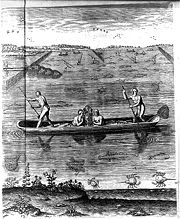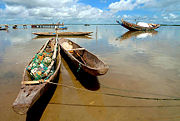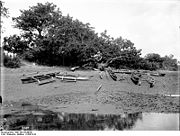- Monoxyla
-
 Amerikanische Ureinwohner mit Einbäumen beim Fischen in der englischen Kolonie Virginia. (Stich von Theodor de Bry 1585 nach einem Aquarell von John White)
Amerikanische Ureinwohner mit Einbäumen beim Fischen in der englischen Kolonie Virginia. (Stich von Theodor de Bry 1585 nach einem Aquarell von John White) Amerikanische Ureinwohner bei der Herstellung eines Einbaums. (Stich von Theodor de Bry 1590 nach einem Aquarell von John White)
Amerikanische Ureinwohner bei der Herstellung eines Einbaums. (Stich von Theodor de Bry 1590 nach einem Aquarell von John White)Der Einbaum ist ein verbreiteter Bootstyp bei Naturvölkern, aber auch in moderneren Gesellschaften noch in Gebrauch. Der Rumpf ist aus einem einzigen Baumstamm gefertigt. Mitunter sind die Bordwände durch eingesetzte Spanten verstärkt und durch das Aufsetzen eines Plankenganges erhöht. Charakteristisch sind auch Querbänke, die nicht eingesetzt, sondern aus den Stamm gearbeitet sind.
Einbaum ist die Übersetzung des griechischen Wortes μονόξυλον - Monoxylon (Plural: μονόξυλα - Monoxyla) ab. „Mono“ bedeutet so viel wie allein, nur und „Xylon“ Holz, Baum.
Inhaltsverzeichnis
Geschichte
Wie archäologische Funde belegen, beherrschten Menschen bereits vor 6.000 Jahren die Kunst, einen Baum auszuhöhlen und ihn zum Transportmittel zu machen. Der Baumstamm wurde im Allgemeinen mit Hilfe von schwelendem Feuer grob ausgehöhlt und mit scharfen Werkzeugen nachbearbeitet. Der Einbaum ist damit eine der Urformen des Bootes.
Vorkommen
Einbäume haben, abhängig auch von der Größe der Bäume in den lokalen Waldbeständen, ein zum Teil beträchtliches Ausmaß. In Äquatorialafrika erreichen Einbäume eine Tragfähigkeit die 70 Personen entspricht. Einbäume wurden in den schweizer Pfahlbauten gefunden, waren im Mittelalter in Gebrauch und im Spreewald bis ins 19. Jahrhundert. Einbäume sind auch heute noch in vielen Regionen der Welt verbreitet, so zum Beispiel in Afrika, Südamerika, Indien und auf Neuguinea. Oft sind sie mit Auslegern versehen. Einige Gruppen fertigen auch Einbäume mit Segeln (Segelkanus) an.
Einbaumfunde
Mesolithisch
- Pesse, Niederlande
- Dümmerlohhausen, Niedersachsen
- Ziesar, Brandenburg
- Einbäume von Stralsund, Mecklenburg-Vorpommern
Neolithisch
- Bercy, Frankreich
- Noyen-sur-Seine, Frankreich
- Twann, Schweiz
Literatur
- Béat Arnold: Pirogues monoxyles d'Europe centrale, construction, typologie, évolution. In: Archéologie neuchâteloise, 20/21 (1995).
- Sean McGrail: Logboats of England and Wales, with comparative material from European and other countries. In: BAR British series, 51 (1978).
- John Holmes: The Waltham Cross dug-out canoe and its implications. Hertford 1954.
Spezielle Einbäume
Weblink
Wikimedia Foundation.


